
Your Invisalign treatment will consist of a series of aligners that you switch out about every two weeks. Each aligner is individually manufactured with exact calculations to gradually shift your teeth into place. And since your Invisalign system is custom-made for your teeth and your teeth only, with a plan devised by you and your dentist or orthodontist, you know you'll end up with a smile that truly fits.
If you're ready for a smile that transforms your appearance, Invisalign is your answer. Although there are many choices out there, no other works as effortlessly as the Invisalign system.
Invisalign is the best way to transform your smile without interfering with your day-to-day life. Check out the benefits below:
Invisalign is a patented proprietary system that uses 3D modeling software and cutting-edge manufacturing technology to provide a clear, removable solution for straightening teeth. Invisalign is effective at treating a wide variety of orthodontic issues including:
a) Crowding
b) Spacing
c) Overbite
d) Underbite
e) Deep bite
f) Open bite
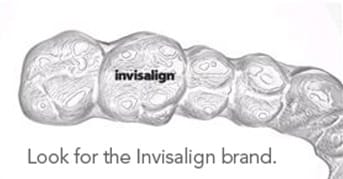
Invisalign was designed with leading orthodontists and is FDA cleared. Invisalign has the experience of over 1,000,000 patients worldwide, and has a 96% of patient satisfaction rate.¹ And, 9 out of 10 patients would recommend Invisalign to their friends and family. In today’s busy and aesthetically-conscious world, many patients prefer Invisalign’s clear and removable orthodontic solution to traditional brackets and wires. There are a number of other clear aligners out there, however none have the product experience, efficacy and customization of Invisalign.
Look for the Invisalign brand on your aligner to insure you are receiving genuine Invisalign system treatment.
So what happens when you decide Invisalign is for you? Simply visit an Invisalign-trained doctor for a consultation to discuss the goals you have for your smile. Once your doctor determines that Invisalign is right for you, he or she will write up a detailed treatment plan, and a set of virtually invisible aligners will then be sent to your doctor. Your Invisalign system may look like a simple piece of plastic, but it's much more. With advanced technology, your Invisalign aligners are custom-made for you, and only you. Over time, your teeth should move to reveal the smile you've been looking for. So take a look at the steps you and your doctor will take to get you to a brand-new smile.
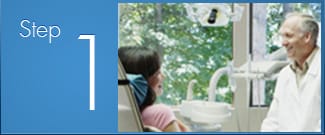
Your initial consultation with our orthodontist, During this visit, you'll discuss the issues you have with your teeth and what kind of results you would like to see. Once our orthodontist decides your situation is suitable for Invisalign treatment, a treatment plan will be mapped out with your goals in mind. Then, impressions and pictures of your teeth will be taken for digitization purposes.

The impressions of your teeth will be digitized in order for our Invisalign orthodontist to work with a computerized 3-D image of your teeth. Then, our orthodontist will plan your tooth movements throughout your entire treatment timeline. You'll be able to see a virtual representation of your teeth before, during, and after completion of the Invisalign process so you can see what your smile should look like when you're done with treatment.
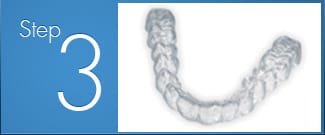
From our orthodontist's precise treatment plan, customized aligners are created with advanced technology for you to wear at each stage of your treatment. While the number of aligners varies for each individual situation, a full set of treatment typically includes 20-30 aligners per arch.
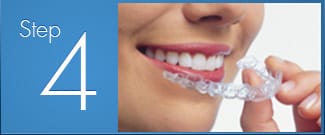
You should wear your aligners at all times, with the exception of eating and drinking, in order to complete your treatment in the timeline determined by you and our orthodontist. You'll go in for occasional checkups, to monitor your progress and to receive your next set of aligners. During the entire treatment process, you'll be able to watch your teeth gradually moving into place. Your smile will, little by little, move into something you'd like to show off. The people around you will be sure to notice your new-found confidence.
Choosing the Invisalign system is a smart decision on your part because the advanced technology provides you with customized treatment to give you a smile that suits you. And even with all that superior technology, we make it easy for you to get Invisalign.
Please ask our OrthoSmile receptionists about our payment options to help you on your way to the smile you've always dreamed of.
The Invisalign process begins with a series of snap-on, custom fit, removable mouth trays, or aligners. These Invisalign aligners apply a controlled amount of pressure to your teeth, forcing them to shift. The process continues with a computer-generated image of what your teeth will look like at each stage of treatment from beginning to end. Each stage corresponds to the movement built into a set of aligners.
Additionally, each aligner is designed to pressure specific teeth to move into places. Like brackets and arch wires, Invisalign Aligners move teeth through the appropriate placement of controlled force on the teeth. The key difference is that Invisalign not only controls forces, but also controls the timing of the force application. At each stage, only certain teeth are able to move and these movements will be determined by the orthodontic treatment plan for that particular stage.

Not only is Invisalign versatile, helping to correct a broad range of dental and orthodontic issues, but it really works. And there are over a million smiles to back that up. But a confident smile isn't the only benefit of correcting your dental issues with custom-made Invisalign aligners—your health can be positively impacted as well. Learn more about several common issues below that an experienced Invisalign doctor can work with you to correct.
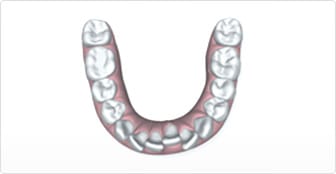
Overly crowded teeth: This occurs when there is simply a lack of room within your jaw for all of your teeth to fit normally. When left untreated, overly crowded teeth can cause dental decay, an increase in chances of gum disease, and can prevent the normal function of teeth.
Widely spaced teeth: This occurs with abnormal continued growth of the jaw bone. When teeth are missing, this issue can also be caused by the other teeth shifting due to extra space. Spacing issues in teeth can cause some periodontal diseases.
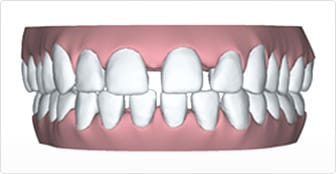

Crossbite: This occurs when the upper and lower jaws are both misaligned. It causes one or more upper teeth to bite on the inside of the lower teeth, and can happen on both the front and/or the sides of the mouth. This issue can cause wear of the teeth, gum disease, and bone loss.
Overbite: What people commonly refer to as an "overbite" is known to dental professionals as "overjet." It occurs when the upper teeth bite over the lower teeth. It's typically caused by either genetics, bad oral habits, or over development of the bone that supports the teeth. This issue can lead to gum problems or irritation, and/or wear on the lower teeth and can cause painful jaw and joint problems.
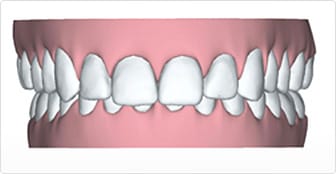
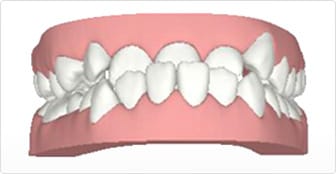
Underbite: This occurs when the lower teeth protrude past the front teeth. It's usually caused by undergrowth of the upper jaw, overgrowth of the lower jaw, or both. It can also be caused by missing upper teeth. This issue can prevent the normal function of front teeth or molars which can lead to tooth wear. It can also cause painful jaw and joint problems.
Our Invisalign doctor will work with you to create a custom-designed program that will treat your specific dental or orthodontic issue(s). Your treatment program will consist of a full set of aligners, made for you, and only you.
While the end results may appear the same—a confident, beautiful smile—when you stop and actually compare Invisalign to other teeth-straightening options, the advantages become quite apparent. Knowing the pros and cons of each option ahead of time will help you make a more confident decision.
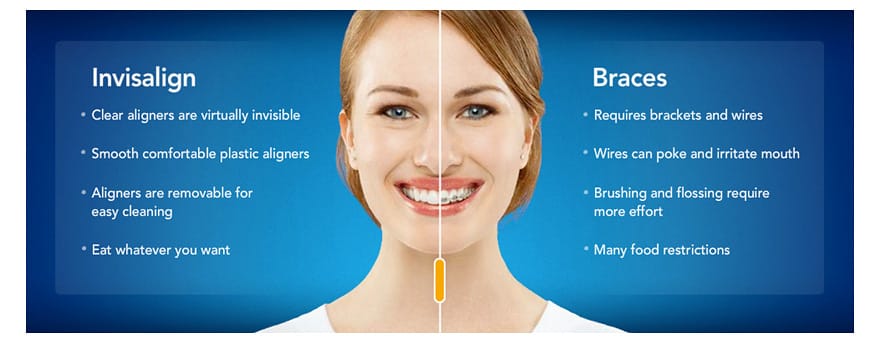

With regular braces, you may experience some or all of the following: pain, discomfort, mouth sores or injuries caused by the brace wires, tooth decay (from inadequate brushing and flossing), plaque buildup, tooth discoloration, tooth/bracket breakage, or difficulty eating. As if that weren’t enough, there are also the personal sacrifices - popcorn, chips, bagels, hard-crusted bread, pizza crust, pretzel, nuts, certain candies…plus apples, carrots, corn on the cob, and more.
Many patients have asked about the benefits of veneers when compared to Invisalign. While veneers are certainly an option for improving your smile, they only cover up certain dental imperfections, rather than correct them. This means that some existing periodontal problems could still remain. Applied to the front side of the teeth only, veneers also require the removal of the surface enamel of each tooth - an irreversible procedure. Often considered a quick fix, veneers typically need to be replaced every 5 to 10 years - this can become very expensive in the long run. Coffee, tea and red wine need to be avoided to prevent discoloration, and care must be taken to prevent chipping or breaking the veneer. So while the surface look of the teeth may improve with veneers, the underlying tooth and gum problems could still exist.
When it comes to considering your options for a smile makeover, it's easy to see Invisalign's advantages. So there's a reason to smile. Compare Invisalign to other teeth straightening options. Then you can see if Invisalign is right for you and your smile.Look at the chart below to see how Invisalign compares to other treatment options. This Invisalign comparison chart is clearly evident that Invisalign outperforms other aligners. When it comes to creating beautiful smiles, Invisalign is the clear winner. Invisalign Teen aligners fit into a teenager’s life—beautifully.
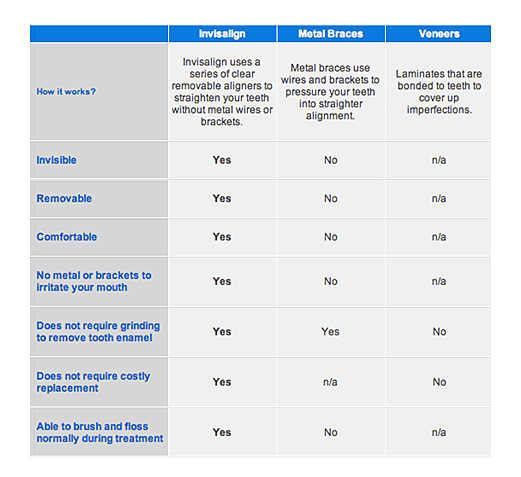
How Invisalign can develop the strength of your mouth Teeth that are packed together or too widely spaced can create unhealthy conditions, including swollen gums, redness and pocketing, all of which are signs of periodontal disease. As Invisalign unnoticeably straightens your teeth, it will also make sure your teeth is aligned properly.
Healthier Gums Thorough research has indicated that gum health may improve with the use of Invisalign during orthodontic treatment. Properly aligned teeth can help gums "fit" tighter around each tooth, which may lead to better periodontal health. As opposed to braces, with Invisalign, you can brush and floss normally, which can help to avoid tooth decay and gum disease.
Easier Cleanings Unlike conventional braces, Invisalign has no metal bands or wires to ensnare with food or plaque. Sustaining a good oral hygiene program will inevitably reduce chances of plaque buildup, tooth decay and gum disease.
Improved Chewing and Speech For most individuals, incorrectly situated teeth and jaws can exacerbate speech impairment and chewing problems. Adjusting your bite by straightening your teeth through Invisalign can help improve both.
Lower Risk of Trauma and Abnormal Wear Teeth that are properly aligned will not cause any burden on the supporting bone and jaw joints
Making the decision to straighten your teeth is much easier when you know that Invisalign is flexible enough to let you live your life the way you want to. With Invisalign, you don't need to worry about the gum and mouth irritation other teeth-straightening methods can cause.
With Invisalign, the aligner trays are not only smooth and comfortable to wear, but they're also removable. That means you can continue doing all the things you normally would, from brushing and flossing, to eating whatever you like. With other devices, brushing and flossing properly can often take up to 30 minutes!
Special occasion coming up? No problem - just take your aligners out for that time and pop them back in when you're ready. Of course, even when you're wearing them, most people won't even know you're going through treatment, because they are virtually invisible!
Invisalign is also ideal for your busy schedule, with fewer doctor visits required (approximately every six weeks).
The Invisalign® system is the virtually invisible way to straighten your teeth and achieve the smile you've always dreamed of. Using advanced 3-D computer-imaging technology, Invisalign depicts your complete treatment plan, from the initial position of your teeth to the final desired position. Then a series of clear aligners are custom-made for your teeth – and your teeth only – to move them little by little. Each aligner is worn for about two weeks before being replaced by the next in the series, until the final position of your teeth is achieved. Your Invisalign treatment time will be determined by your doctor, based on your specific needs.
Invisalign aligners are practically clear. No one may even notice that you're wearing these virtually invisible "braces," making Invisalign a seamless fit with your lifestyle and day-to-day interactions with others.
Invisalign is removable. Unlike braces, you have the flexibility to eat and drink what you want during treatment by simply removing the aligners. And you can also remove the aligners to brush and floss as you normally would for fresh breath and good oral hygiene.
Unlike braces, there are no metal brackets or wires with the Invisalign system that could cause irritation to your mouth. Plus since your office visits during treatment don't involve metal or wire adjustments, you'll likely spend less time in the doctor's chair.
And finally, Invisalign allows you to view your virtual results and treatment plan before you start so you can see how your straight teeth will look when your treatment is complete.
More than 1,000,000 patients worldwide have been treated with Invisalign. The number of Invisalign smiles grows daily.
It's simple, just make an appointment with an Invisalign Preferred Provider for an initial consultation. Many doctors offer free initial consultations. For the best experience, take the time to find the “right” doctor — one who you feel comfortable with and who has experience treating cases like yours. Like with other important dental decisions, sometimes it is worthwhile to seek out a second or even third opinion. Use our Find-A-Doctor feature to find the most experienced Invisalign-trained doctor near you. Doctors designated as Premier Providers have a greater levels of case experience. Those labeled Premier Provider Elite have the highest levels of case experience. Make sure you trust your smile to an experienced doctor who uses the latest techniques.
More than 1,000,000 patients worldwide have been treated with Invisalign. The number of Invisalign smiles grows daily.
All dentists interested in treating patients with Invisalign must attend and complete specialized instructional sessions to become trained Invisalign providers. In addition, doctors must maintain regular treatment submission and have complete ongoing clinical training classes to earn the designation “Preferred Provider.” Use our Find-A-Doctor feature to find the most experienced Invisalign Preferred Provider near you.
Like brackets and arch wires are to braces, Invisalign aligners move teeth through the appropriate placement of controlled force on your teeth. The main difference is that Invisalign not only controls forces, but also the timing of the force application. During each stage, only certain teeth are allowed to move. These movements are determined by your doctor as he or she maps out your unique Invisalign treatment plan.
The virtually invisible aligners, which are made of a thermoplastic material uniquely developed for the Invisalign treatment plan, look similar to tooth-whitening trays. Invisalign aligners are custom-made for you and only you to move your teeth in the sequence determined by your doctor.
No. Invisalign aligners and Vivera Retainers do not contain B isphenol-A or phthalate plasticizers. These aligners and retainers are made with USP Class VI medical grade, high molecular weight, polyurethane resins. Tests have been conducted to determine the biocompatibility of these materials, and show that they are biocompatible and pass all applicable regulatory requirements and thresholds for human wear in the mouth. Of course, as with any medical device, you should consult with your health professional about your aligner or retainer treatment and any applicable risks of use.
A number of Invisalign patients have undergone a previous treatment involving braces at some point in their past, often during their youth. Invisalign can usually correct the shifting that occurs after braces, and do so without having to go through the trauma and social awkwardness of wearing metal braces.
Doctors are treating a significant number of patients with a combination of braces and Invisalign. Consult your Invisalign doctor to determine the best treatment for you.
All dentists interested in treating patients with Invisalign must attend and complete specialized instructional sessions to become trained Invisalign providers. In addition, doctors must maintain regular treatment submission and have complete ongoing clinical training classes to earn the designation “Preferred Provider.” Use our Find-A-Doctor feature to find the most experienced Invisalign Preferred Provider near you.
Similar to other orthodontic treatments, Invisalign aligners may temporarily affect the speech of some people, and you may have a slight lisp for a day or two. However, as your tongue gets used to having aligners in your mouth, any lisp caused by the aligners should disappear.
No. Thanks to the removable nature of the aligners, you can eat and drink whatever you want while in treatment. In fact, you're required to remove your aligners to eat and drink. So, unlike undergoing traditional treatment using wires and brackets, there is no need to restrict your consumption of any of your favorite foods and snacks unless instructed otherwise by your doctor. Also, it is important that you brush your teeth after each meal and prior to re-inserting your aligners to maintain fresh breath and proper hygiene.
We discourage smoking while wearing aligners because it is possible for the aligners to become discolored.
No, gum will stick to the aligners. We recommend removing your aligners for all meals and snacks.
While Invisalign moves your teeth without the pain and anxiety of metal braces, some people will experience temporary discomfort for a few days at the beginning of each new stage of treatment. This is normal and is typically described as a feeling of pressure. It's also a sign that Invisalign is working, as it moves your teeth to their final destination. This discomfort typically goes away in a couple of days.
The best way to clean your aligners is to use the Invisalign cleaning kit, available for order at www.invisalignstore.com. As a secondary method, however, your aligners can also be cleaned by brushing them and rinsing them in lukewarm water.
We find aligners are most effective if worn 20 to 22 hours per day – and removed only for eating, brushing, and flossing.
Your doctor will schedule regular appointments – usually about once every four to six weeks. The goal of these visits are to ensure that your treatment is progressing as planned.
Align Technology, Inc., the company that manufactures Invisalign, was founded in 1997.
Invisalign aligners are classified as Class II medical devices by the FDA, and Align Technology, Inc.has held the necessary 510K clearance from the FDA since 1998 to be able to sell and market the Invisalign system.
Invisalign Teen is appropriate for patients who have shed all of their baby teeth and have second molars at least partially erupted – this includes most teens. Ask your orthodontist if you qualify to start treatment now.
The length of treatment depends on the severity of your case and can only be determined by your doctor; however the average case takes about 12 months.*
This varies person to person and depends on the outcome of the treatment. Some patients might need a positioner, or conventional retainer. Other patients might need a clear plastic retainer similar to the ones Invisalign makes, such as Align Technology's Vivera Retainer, (www.viveraretainer.com). Discuss this with your dentist. Every patient is different, and outcomes vary.